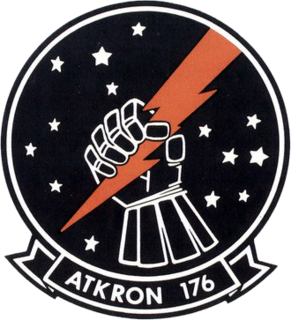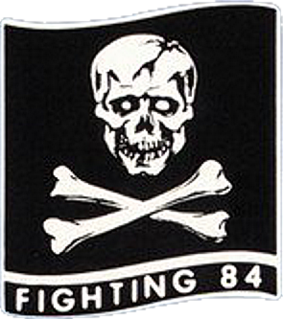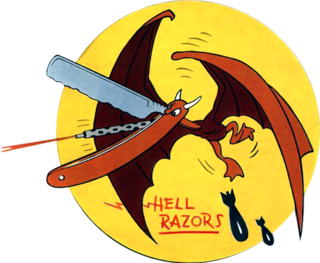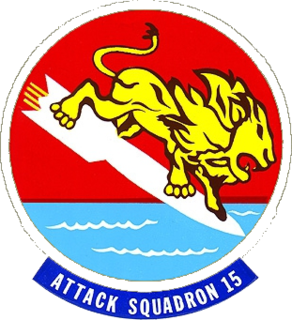
Attack Squadron 176 (VA-176), known as the "Thunderbolts", was a United States Navy carrier-based medium attack squadron that saw combat service in the Vietnam War and later in 1983 in both Grenada and Lebanon.

Strike Fighter Squadron 211 (VFA-211), nicknamed the "Fighting Checkmates", is an aviation unit of the United States Navy established in 1945. The squadron is based at Naval Air Station Oceana and is equipped with the F/A-18E Super Hornet.

VF-84, Fighter Squadron 84 was an aviation unit of the United States Navy. Originally established as VA-86 on 1 July 1955, it was immediately redesignated as VF-84, it was disestablished on 1 October 1995. It was the third US Navy squadron to be designated as VF-84. The squadron was nicknamed the Jolly Rogers and was based at NAS Oceana. It took the number but not the lineage of VF-84 the "Wolf Gang" and the insignia of VF-61 the Jolly Rogers.

Strike Fighter Squadron 103 (VFA-103), nicknamed the Jolly Rogers is an aviation unit of the United States Navy established in 1952. VFA-103 flies the F/A-18F Super Hornet and is based at Naval Air Station Oceana, Virginia (US). The squadron's radio callsign is Victory and it is assigned to Carrier Air Wing Seven.

A carrier air wing is an operational naval aviation organization composed of several aircraft squadrons and detachments of various types of fixed-wing and rotary-wing aircraft. Organized, equipped and trained to conduct modern US Navy carrier air operations while embarked aboard aircraft carriers, the various squadrons in an air wing have different but complementary missions, and provide most of the striking power and electronic warfare capabilities of a carrier battle group (CVBG). While the CVBG term is still used by other nations, the CVBG in US parlance is now known as a carrier strike group (CSG).

Strike Fighter Squadron 11 (VFA-11) is a United States Navy strike fighter squadron stationed at Naval Air Station Oceana, Virginia, United States. The squadron was established in 1950 and is nicknamed "Red Rippers". VFA-11 is equipped with the Boeing F/A-18F Super Hornet and currently assigned to Carrier Air Wing One.

Strike Fighter Squadron 115 (VFA-115) is known as the "Eagles", callsign "Talon", a United States Navy F/A-18E Super Hornet strike fighter squadron stationed at Marine Corps Air Station Iwakuni. Their tail code is NF. It was established as Torpedo Squadron VT-11 on 10 October 1942, redesignated VA-12A on 15 November 1946, VA-115 on 15 July 1948, then finally VFA-115.

Attack Squadron 65 (VA-65), nicknamed The World Famous Fighting Tigers, was an attack squadron of the United States Navy. The squadron was established as Torpedo Squadron VT-74 in 1945, redesignated as VA-2B in 1946, as VA-25 on 1 September 1948, and finally redesignated VA-65 on 1 July 1959. It was disestablished in 1993. Known as "The World Famous Fighting Tigers", VA-65 was one of the last medium attack squadrons to fly the A-6 Intruder and the A-1 Skyraider. It was the second squadron to be designated VA-65, the first VA-65 was redesignated from VA-6B on 27 July 1948 and would be redesignated as VA-25 on 1 July 1959.

Strike Fighter Squadron 34 (VFA-34), also known as the "Blue Blasters", is a United States Navy F/A-18E Super Hornet strike fighter squadron stationed at Naval Air Station Oceana. They are a part of Carrier Air Wing 1 and are attached to the aircraft carrier USS Harry S. Truman. Their tail code is AB and their radio call sign is "Joker".

Strike Fighter Squadron 81 (VFA-81), also known as the "Sunliners", is a United States Navy F/A-18E Super Hornet strike fighter squadron stationed at Naval Air Station Oceana. They are a part of Carrier Air Wing One, their radio callsign is Inferno, and their tail code is AB. Their mission is to conduct prompt and sustained combat operations from the sea. The squadron was originally designated VA-66 on 1 July 1955, was redesignated VF-81 the same day, redesignated VA-81 on 1 July 1959, and finally redesignated VFA-81 on 4 February 1988.

Attack Squadron 174 (VA-174) also known as the "Hellrazors" was a United States Navy attack squadron based at Naval Air Station Cecil Field, Florida, and were attached to Light Attack Wing One. It was commissioned from 1944 to 1988.

VA-52 was an Attack Squadron of the U.S. Navy. It was established as U.S. Navy Reserve Fighter Squadron VF-884 on 1 November 1949, and called to active duty on 20 July 1950. It was redesignated VF-144 on 4 February 1953, and VA-52 on 23 February 1959. The squadron was nicknamed the Bitter Birds from about 1951–1953, and the Knightriders from about 1960 onward. Its insignia evolved through several versions and variations from 1951 to the 1980s. VA-52 was decommissioned on 31 March 1995.

Attack Squadron 54 (VA-54) was an attack squadron of the U.S. Navy. Originally established as Bomber Fighter Squadron VBF-153 on 26 March 1945, redesignated Fighter Squadron VF-61A (VF-16A) on 15 November 1946, redesignated VF-152 on 15 July 1948, and VF-54 on 15 February 1950. It was finally redesignated VA-54 on 15 June 1956. The squadron was disestablished on 1 April 1958. It was the second squadron to be designated VA-54, the first VA-54 was disestablished on 1 December 1949.

Attack Squadron 85 or VA-85 was a long-lived Attack Squadron of the U.S. Navy. It was called to active duty as U.S. Navy Reserve squadron VA-859 on 1 February 1951 and redesignated VA-85 on 4 February 1953. It was disestablished on 30 September 1994, over 40 years later. The squadron's nickname from 1958-1994 was the Black Falcons. It was the second squadron to be designated VA-85, the first VA-85 was disestablished on 29 November 1949.

Attack Squadron 196 (VA-196) was an aviation unit of the United States Navy. It was established as Fighter Squadron 153 (VF-153) on 15 July 1948, redesignated as VF-194 on 15 February 1950, and finally redesignated VA-196 on 4 May 1955. Its nicknames were the Thundercats from 1948 to the 1950s, and The Main Battery from the 1950s thereafter. Beginning in 1979 the squadron used the nickname Milestones interchangeably with Main Battery. The squadron was disestablished on 21 March 1997, after more than 48 years of service.

VA-34, nicknamed the Blue Blasters, was an Attack Squadron of the U.S. Navy. The squadron was established as Fighter Squadron VF-20 on 15 October 1943, redesignated as VF-9A on 15 November 1946, as VF-91 on 12 August 1948, and as VF-34 on 15 February 1950. It was finally redesignated VA-34 on 1 July 1955. The squadron was disestablished on 1 June 1969. It was the second squadron to bear the VA-34 designation, the first one having been renamed VA-35 in 1950.

Attack Squadron 15 (VA-15), nicknamed the Valions, was an aviation unit of the United States Navy. It was established as Torpedo Squadron 4 (VT-4) on 10 January 1942, redesignated VA-2A on 15 November 1946, and finally redesignated VA-15 on 2 August 1948. The squadron was disestablished on 1 June 1969, after 27 years of service.

VA-44, nicknamed the Hornets, was an Attack Squadron of the US Navy. The squadron was established as Fighter Squadron VF-44 on 1 September 1950, and redesignated VA-44 on 1 January 1956. It was disestablished on 1 May 1970. It was the second squadron to be designated VA-44, the first VA-44 was disestablished on 8 June 1950.
VF-43 was a Fighter Squadron of the U.S. Navy. The squadron was originally established as Fighter Squadron 74A (VF-74A) on 1 May 1945, it was redesignated Fighter Squadron 74 (VF-74) on 1 August 1945, redesignated VF-1B on 15 November 1946, redesignated VF-21 on 1 September 1948, redesignated as Attack Squadron 43 (VA-43)Challengers on 1 July 1959 and Fighter Squadron 43 (VF-43) on 1 June 1973. It was disestablished on 1 July 1994.


























